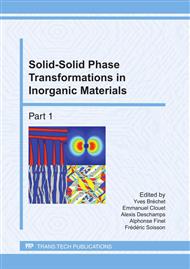p.79
p.84
p.90
p.99
p.105
p.111
p.117
p.123
p.129
Special Microstructures and Twin Features in Ti50Ni50-X(Pd,Au)X at Small Hysteresis
Abstract:
The breaking of symmetry due to atomic displacements in the austenite-martensite phase transformation generally leads to their crystallographic incompatibility. Energy minimizing accommodation mechanisms such as martensite twinning have been recently shown to be a source of hysteresis and irreversible plastic deformation. Compatibility between the two phases can however be achieved by carefully tuning lattice parameters through composition change. A dramatic drop in hysteresis and novel microstructures such as a lowering of the amount of twin lamella are then observed. Related theoretical and simulation works also support the existence of such microstructures including peculiar self-accommodating configurations at near-compatibility. We present the transmission electron microscopy (TEM) study of these novel microstructures for the alloy systems Ti50Ni50-xPdx and Ti50Ni50-xAux where the composition was systemically tuned to approach perfect compatibility. High resolution imaging of the interface between austenite and martensite supplies evidences of compatibility at the atomic level.
Info:
Periodical:
Pages:
105-110
Citation:
Online since:
June 2011
Authors:
Price:
Сopyright:
© 2011 Trans Tech Publications Ltd. All Rights Reserved
Share:
Citation:


